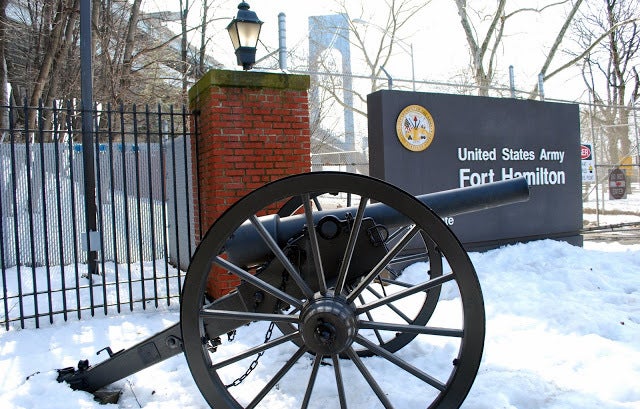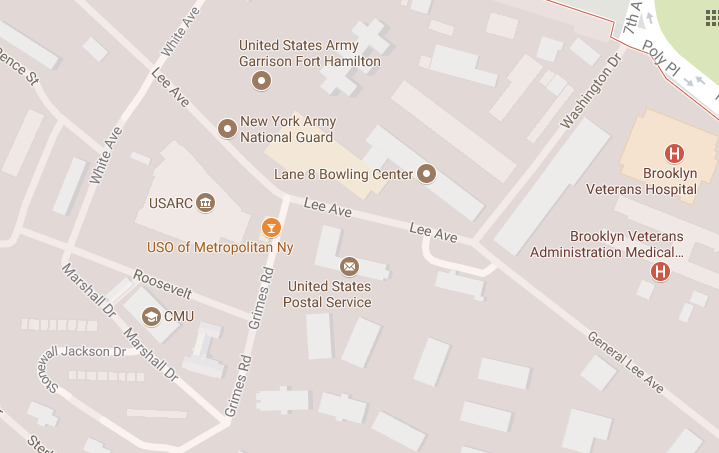
Fort Hamilton in Brooklyn, New York
Stonewall Jackson Drive and General Lee Avenue are on the Fort Hamilton military base near Bay Ridge in Brooklyn. The street names honor pro-slavery Confederate Army Generals. Jackson and Lee both were stationed at the base in the 1840s prior to the Civil War. They also both violated the 1789 military oath of allegiance to “support the constitution of the United States” and to serve “honestly and faithfully” against “enemies or opposers.”
Thomas “Stonewall” Jackson graduated from West Point and served in the U.S Army during the Mexican-American War (1846-1848). He later took up arms against the United States during the Civil War, leading Confederate forces at the battles of Bull Run, Antietam, and Fredericksburg. He died of complications from wounds in 1863. Not only was Jackson a traitor, he was also a slaveholder.
Robert E. Lee was also a West Point graduate and a veteran of the Mexican-American War. He later served as superintendent of the military academy and Lincoln offered him command of the U.S. army at the outbreak of the Civil War. Lee refused the offer and instead became commander of the army of Northern Virginia and later the Confederate General-in-Chief, leading Southern forces at Antietam and Gettysburg. At the end of the Civil War, Lee, a traitor and a former slaveholder, opposed granting Blacks the right to vote. Recently his statue was removed from prominent display in New Orleans.
Brooklyn Congressional Representatives Yvette Clarke, Jerrold Nadler, Nydia Velazquez and Hakeem Jeffries are demanding that the names of these streets be changed. In a letter to Army Secretary Robert Speer they wrote “To honor these men who believed in the ideology of white supremacy and fought to maintain the institution of slavery constitutes a grievous insult to the many thousands of people in Brooklyn who are descendants of the slaves held in bondage.”

Street map of the Fort Hamilton base.
An army spokesperson responded that “historic names represent individuals, not causes or ideologies” and that “the naming occurred in the spirit of reconciliation, not division.” However, in 2000 the army did rename a street at Fort Bliss in El Paso, Texas, that honored Confederate General Nathan Bedford Forrest, a founder of the Ku Klux Klan. A number of other U.S. military installations are still named after Confederate leaders including Fort Lee in Virginia, Fort Hood in Texas, Fort Benning in Georgia, and Camp Beauregard in Louisiana.
New Orleans Mayor Mitch Landrieu, who authorized the removal of the Lee statue as well as others honoring Confederate heroes, made clear that “They were not statutes that were put up to honor those particular men. It was to send a message that the Confederacy was really the right cause, and not the wrong cause.”
Harvard historian Annette Gordon-Reed responded to claims that the removal of the New Orleans statues could lead to a disavowal of national founders like George Washington and Thomas Jefferson who were also slaveholder. According to Gordon-Reed, it is important to “distinguish between people who wanted to build the United States of America and people who wanted to destroy it. It’s possible to recognize people’s contributions at the same time as recognizing their flaws.”
Because Fort Hamilton is a federal facility, New Yorkers can only petition the military to have the street names changed. But there are other actions that can be taken by local authorities. Stuyvesant High School and Stuyvesant Town in Manhattan are named after Peter Stuyvesant, the last of director-general New Amsterdam. Stuyvesant was a virulent anti-Semite and the largest private slaveholder in the Dutch colony. Francis Lewis High School and boulevard in Queens are named after a signer of the Declaration of Independence who was also a slave trader. Citi Field in Queens and and Barclays Center in Brooklyn bear the names of banks involved in financing the trans-Atlantic slave trade. John Mullaly Park near Yankee Stadium in the Bronx is named after an avoid racist who incited anti-Black race riots during the Civil War. The Central Park statue honoring James Marion Sims honors a doctor who conducted experimental gynecological operations on enslaved African women without the benefit of anesthesia or antiseptics. New York needs to revisit this part of its history.
On a more positive note, Metro Tech Plaza in Brooklyn is the location where free Blacks, escaped slaves, and abolitionist allies awaited and celebrated the Emancipation Proclamation on New Year’s Eve 1863. It should be renamed Grand Emancipation Jubilee Plaza.
Follow Alan Singer on Twitter: https://twitter.com/ReecesPieces8
